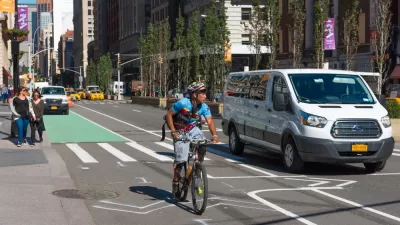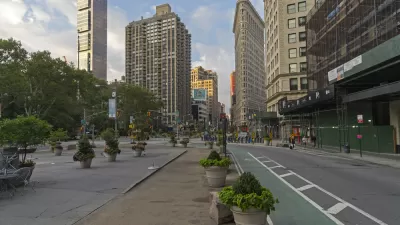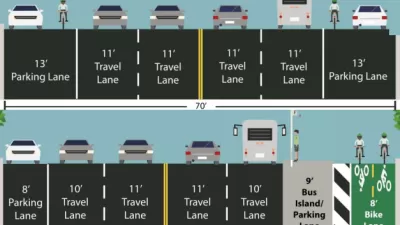Urban bike infrastructure is plagued by three related problems: design, politics, and security.

Slate writer Henry Grabar blasts cities for bike networks that leave cyclists unsafe and uninspired. Drawing on his experiences as a bicycle commuter in New York, he illustrates common "design flaw[s]" that are "born of politics but compounded by disinterested policing."
On the design front, Grabar describes bike lanes that are poorly protected from traffic and paths that end abruptly, creating gaps in the system: "The network is only as strong as its weak points, which can be very weak."
He attributes those weak points to the fact that power over New York’s bike lanes goes to community boards—resulting in a patchwork governance process that de-prioritizes holistic planning:
Transportation planning is the quintessential issue that should not be left to local determination. But bike lanes, for some reason, are subject to the whims of neighborhoods.
Nor, he suggests, can New Yorkers expect action from the police on cars that park or drive in unprotected bike lanes, forcing cyclists to swerve into traffic or ride on the sidewalk.
"If the NYPD can’t keep the lanes clear, there’s no point in having them," he writes.
FULL STORY: Why Bicycling Infrastructure Fails Bicyclists

Alabama: Trump Terminates Settlements for Black Communities Harmed By Raw Sewage
Trump deemed the landmark civil rights agreement “illegal DEI and environmental justice policy.”

Planetizen Federal Action Tracker
A weekly monitor of how Trump’s orders and actions are impacting planners and planning in America.

The 120 Year Old Tiny Home Villages That Sheltered San Francisco’s Earthquake Refugees
More than a century ago, San Francisco mobilized to house thousands of residents displaced by the 1906 earthquake. Could their strategy offer a model for the present?

In Both Crashes and Crime, Public Transportation is Far Safer than Driving
Contrary to popular assumptions, public transportation has far lower crash and crime rates than automobile travel. For safer communities, improve and encourage transit travel.

Report: Zoning Reforms Should Complement Nashville’s Ambitious Transit Plan
Without reform, restrictive zoning codes will limit the impact of the city’s planned transit expansion and could exclude some of the residents who depend on transit the most.

Judge Orders Release of Frozen IRA, IIJA Funding
The decision is a victory for environmental groups who charged that freezing funds for critical infrastructure and disaster response programs caused “real and irreparable harm” to communities.
Urban Design for Planners 1: Software Tools
This six-course series explores essential urban design concepts using open source software and equips planners with the tools they need to participate fully in the urban design process.
Planning for Universal Design
Learn the tools for implementing Universal Design in planning regulations.
Clanton & Associates, Inc.
Jessamine County Fiscal Court
Institute for Housing and Urban Development Studies (IHS)
City of Grandview
Harvard GSD Executive Education
Toledo-Lucas County Plan Commissions
Salt Lake City
NYU Wagner Graduate School of Public Service





























